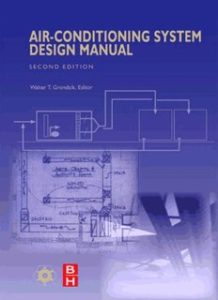Air Conditioning System Design Manual
Air Conditioning System Design Manual
Air Conditioning System Design Manual was prepared to assist entry-level engineers in the design of air-conditioning systems. It is also usable—in conjunction with fundamental HVAC&R resource materials—as a senioror graduate-level text for a university course in HVAC system design. This manual was intended to fill the void between theory and practice, to bridge the gap between real-world design practicesand the theoretical knowledge acquired in the typical college course or textbook. Courses and texts usually concentrate on theoretical calculations and analytical procedures or they focus upon the design of components. This manual focuses upon applications.
This second edition represents a major update and revision of the ASHRAE Design Manual. The request that drove this revision effort was simply to make a successful resource more current. The revision process involved a thorough editing of all text in the manual, the addition of SI units throughout, the updating of references, and the editing of many illustrations. New material dealing with design process, indoor air quality, desiccant dehumidification, and “green” HVAC&R systems was added.
You can also Read An Introduction to Thermogeology: Ground Source Heating and Cooling, 2nd Edition
Content
- Preface
![Air Conditioning System Design Manual]()
- Acknowledgments
- Introduction
- The Design Process
- Occupant Comfort and Health
- Load Calculations
- Components
- All-Air HVAC Systems
- Air-and-Water Systems
- All-Water Systems
- Special HVAC Systems
- HVAC&R Controls
- A – Proposed Mechanical and Electrical Systems for an Office Building with Retail Stores
- B – Design Calculations for a Typical Single-Zone HVAC System
- C – Design Calculations for a Single-Duct VAV System with Perimeter Radiation
- D – All-Water System
- E – Preliminary Comparison of Conventional and Ice Storage Systems for a Four-Story Office Building
- F – Controls
- Index
The manual has two main parts: (1) a narrative description of design procedures and criteria organized into ten chapters and (2) six
appendices with illustrative examples presented in greater detail.


DFEWFE